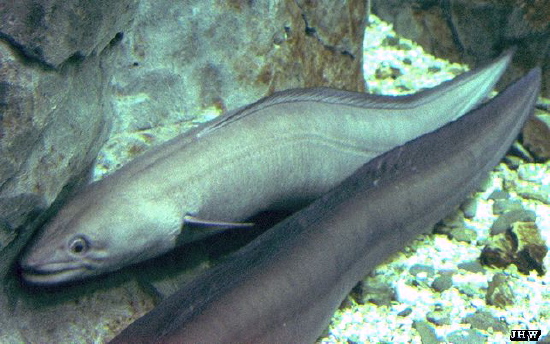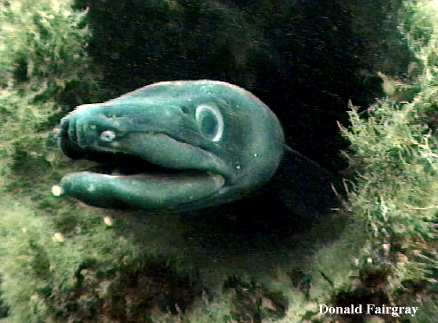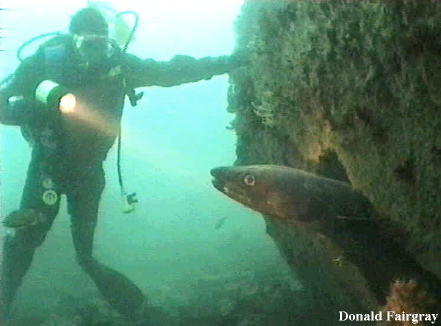Identification:
There are eight distinct species of Conger found in the Atlantic, but Conger
oceanicus is the largest and most common. Specimens up to 250lbs have been
taken by commercial fisherman although any fish caught on rod and line over
70lbs would be considered a specimen. The Conger has a scaleless skin and
its upper jaw extends beyond its lower. Colouring very much depends on the
type of seabed it inhabits. On rocks, the back is charcoal grey and the
underparts are pale, but over sand the back is a light-grey brown. The margins
of the dorsal and anal fins are black. The conger can normally be differentiated
from another eel merely by its size. However, small fish can be identified
by the dorsal fin beginning at the pectoral fins and running the length of
its body. The dorsal fin on a silver eel begins well back from its pectoral
fins.
Breeding:
The breeding cycle of the Conger is still something of a mystery
due to the enormous distances that they will travel to spawn. It is thought
that the Conger migrate to the Sargasso Sea in the sub-tropical Atlantic
to breed, spawning at depths of 10,000 to 12,000 ft. The larvae are transparent
and flattened, and drift at the surface for up to 2 years before reaching
the shoreline where they become cylindrical. At this stage they are still
transparent and about 3 inches long. The full colouring appears by the time
the eel is 12 inches long.
Habitat:
Conger Eels favour very rough ground and inhabit deepwater wrecks,
reefs and broken ground. In shallow waters Conger are mostly nocturnal feeders,
but in depths of 60ft or more they feed at any time.
Food:
Conger are bottom feeders more than capable of catching live food.
They will hole up in a wreck or rough ground and ambush lesser species. They
will take fish baits, crab, cuttlefish and squid. The most popular bait is
a mackerel 'flapper' produced by taking the whole fish and removing the backbone
and tail, allowing the flanks and innards to flutter in the tide. If it is
available, a whole live pout can prove deadly.
Range:
English Channel, North Sea, Irish Sea
Additional Notes:
Conger eels have extremely sharp teeth and strong jaws. Hook lengths should
be constructed of wire or heavy duty monofilament to avoid being bitten through.
Conger stay alive for long periods out of water and great caution should
be exercised when unhooking. Conger flesh is relatively tough but eating
quality is fair if cooked properly, often as Conger steaks.
Useful Contacts: British Conger Club
DIANNE BYRNE, BCC SECRETARY, 2 DRAKE COURT, 264 CITADEL ROAD,PLYMOUTH. PL12PY.
EMAIL. secretary@congerclub.org
|


